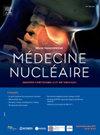Comparative evaluation by SPECT and PET imaging of two immuno-pre-targeting systems in an in vivo model of triple negative breast tumours with anti-EGFR
IF 0.2
4区 医学
Q4 PATHOLOGY
Medecine Nucleaire-Imagerie Fonctionnelle et Metabolique
Pub Date : 2025-02-01
DOI:10.1016/j.mednuc.2024.12.058
引用次数: 0
Abstract
Objectives
One of the main criticisms of pretargeting approaches, which separate antigen-binding from radionuclides injection, is the required use of slowly or non-internalizing monoclonal antibodies (mAb), which limits the number of antibodies that can be used. However, a recent study has shown the possibility to achieve 3.7% tumour uptake with internalized antibodies using the inverse electron-demand Diels-Alder (compared to 30% with non-internalized mAb). To improve in vivo ligation performance with clinically relevant internalized mAbs, we investigated the influence of different pegylated tetrazine probes using two systems (TCO/Tz and BCN/Tz) in a triple negative breast cancer preclinical model.
Methods
We have studied three internalizing anti-EGFR mAbs – Cetuximab, Matuzumab and Panitumumab functionalized by TCO or BCN entities. Their reactivity was assessed by electrophoresis gel, FACS and confocal imaging with fluorescent tetrazine on three cell lines depending on their EGFR antigen expression (MCF-7, MDA-MB-431, MDA-MB-468). Based on these in vitro results, we compared biodistribution by SPECT and PET imaging of the most efficient TCO- and BCN-mAb conjugates in tumour-bearing mice (n = 4/time point).
Results
Best in vitro biorthogonal reactions between TCO/Tz and BCN/Tz were obtained with Panitumumab on MDA-MB-468 cell line as demonstrated by electrophoresis gel, FACS and confocal microscopy. In parallel, the four radiolabeled probes were obtained with good decay-corrected radiochemical yields and excellent radiochemical purities (RCP > 99%). Their stability in murine plasma was higher than 80% over a period of one hour. In vivo, we observed a rapid clearance for all radioactive probes, mainly through urinary elimination, as demonstrated by high kidneys and bladder activity accumulation 30 minutes post-injection. In addition, and in accordance our previous studies, the PEG4 probes also showed a clearance through the hepato-biliary and digestive tract. For all probes, low tumour uptake was achieved. The highest uptake was observed with TCO immuno-conjugates combined with 111In labeled probes using PEG4 or PEG11 for BCN conjugates.
Conclusions
Despite good in vitro results obtained with Panitumumab, this work resulted in a too low tumoral uptake of both Panitumumab conjugates in tumour-bearing mice to allow in vivo imaging by pretargeted PET and SPECT imaging.
求助全文
约1分钟内获得全文
求助全文
来源期刊
CiteScore
0.30
自引率
0.00%
发文量
160
审稿时长
19.8 weeks
期刊介绍:
Le but de Médecine nucléaire - Imagerie fonctionnelle et métabolique est de fournir une plate-forme d''échange d''informations cliniques et scientifiques pour la communauté francophone de médecine nucléaire, et de constituer une expérience pédagogique de la rédaction médicale en conformité avec les normes internationales.

 求助内容:
求助内容: 应助结果提醒方式:
应助结果提醒方式:


